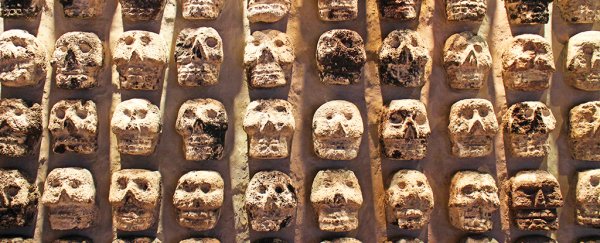In what must count as one of the most chilling discoveries in recent history, archaeologists have unearthed a tower of more than 650 skulls under Mexico City – a find which means we might have to rethink what we thought we knew about the Aztecs.
In particular, some new questions have been raised about the role human sacrifice played in the civilisation, because many of the excavated skulls belonged to women and children.
That challenges the conventional idea that these skull towers were made up of the remains of defeated warriors, put in place as motivation for soldiers going out to battle, according to the team investigating the find.
"We were expecting just men, obviously young men, as warriors would be, and the thing about the women and children is that you'd think they wouldn't be going to war," one of the archaeologists, Rodrigo Bolanos from the National Institute of Anthropology and History (INAH) in Mexico, told Reuters.
"Something is happening that we have no record of, and this is really new, a first in the Huey Tzompantli."
Huey Tzompantli is the name given to the racks of skulls noted in records left by Spanish conquerors when they took the Aztec capital Tenochtitlan in the 16th century. The city eventually became Mexico City.
Because of those accounts, we've always known these skulls were there, hidden away underground, but the latest excavation work is enabling experts to get a closer look at these monuments to death.
The practice of putting severed heads on top of racks as a badge of victory was common in Mesoamerican cultures before the Spanish conquest, but the INAH archaeologists weren't expecting women and children to be among them.
Have they stumbled across more evidence of the Aztec's fondness for human sacrifice? The society was thought to regularly slaughter people – usually captured warriors – in order to keep the gods pleased.
Depictions of sacrifice can be found throughout Aztec religious literature of the time, but women and children wouldn't usually be among captured warriors.
There's still a lot we don't know for certain about how the Aztecs picked their candidates for sacrifice, but one possible explanation is that these women and children were slaves rather than soldiers.
Even sports matches were sometimes used to select victims, experts think – which must've put a lot of pressure on a team to turn in a good performance.
The dig underneath Mexico City was started in 2015 and to date the experts have lifted out 676 skulls, caked in lime, to get a better look at them. These heads would've been put on public display before being moved to the Templo Mayor temple.
Measuring about 6 metres (20 feet) in diameter, the sinister tower of skulls is thought to form part of the chapel of Huitzilopochtli, the Aztec god of the Sun, war and human sacrifice.
Archaeologists are still working to get to the tower's base, and many more skulls are waiting to be discovered, which might give us some idea of what the purpose of the tower was and the people these skulls came from – but it looks like there's much more to the Huey Tzompantli than we thought.
